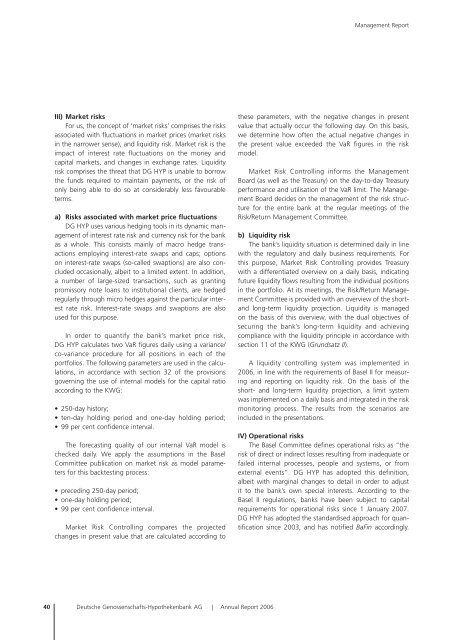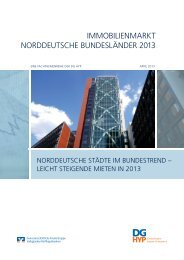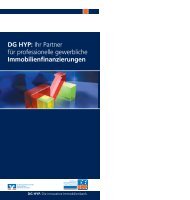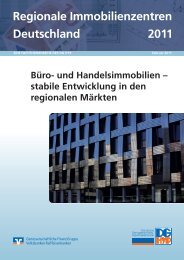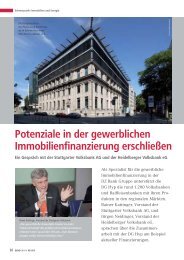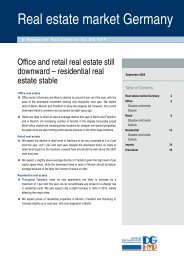ANNUAL REPORT 2006 - DG Hyp
ANNUAL REPORT 2006 - DG Hyp
ANNUAL REPORT 2006 - DG Hyp
Create successful ePaper yourself
Turn your PDF publications into a flip-book with our unique Google optimized e-Paper software.
III) Market risks<br />
For us, the concept of ‘market risks’ comprises the risks<br />
associated with fluctuations in market prices (market risks<br />
in the narrower sense), and liquidity risk. Market risk is the<br />
impact of interest rate fluctuations on the money and<br />
capital markets, and changes in exchange rates. Liquidity<br />
risk comprises the threat that <strong>DG</strong> HYP is unable to borrow<br />
the funds required to maintain payments, or the risk of<br />
only being able to do so at considerably less favourable<br />
terms.<br />
a) Risks associated with market price fluctuations<br />
<strong>DG</strong> HYP uses various hedging tools in its dynamic management<br />
of interest rate risk and currency risk for the bank<br />
as a whole. This consists mainly of macro hedge transactions<br />
employing interest-rate swaps and caps; options<br />
on interest-rate swaps (so-called swaptions) are also concluded<br />
occasionally, albeit to a limited extent. In addition,<br />
a number of large-sized transactions, such as granting<br />
promissory note loans to institutional clients, are hedged<br />
regularly through micro hedges against the particular interest<br />
rate risk. Interest-rate swaps and swaptions are also<br />
used for this purpose.<br />
In order to quantify the bank’s market price risk,<br />
<strong>DG</strong> HYP calculates two VaR figures daily using a variance/<br />
co-variance procedure for all positions in each of the<br />
portfolios. The following parameters are used in the calculations,<br />
in accordance with section 32 of the provisions<br />
governing the use of internal models for the capital ratio<br />
according to the KWG:<br />
• 250-day history;<br />
• ten-day holding period and one-day holding period;<br />
• 99 per cent confidence interval.<br />
The forecasting quality of our internal VaR model is<br />
checked daily. We apply the assumptions in the Basel<br />
Committee publication on market risk as model parameters<br />
for this backtesting process:<br />
• preceding 250-day period;<br />
• one-day holding period;<br />
• 99 per cent confidence interval.<br />
Market Risk Controlling compares the projected<br />
changes in present value that are calculated according to<br />
40 Deutsche Genossenschafts-<strong>Hyp</strong>othekenbank AG | Annual Report <strong>2006</strong><br />
Management Report<br />
these parameters, with the negative changes in present<br />
value that actually occur the following day. On this basis,<br />
we determine how often the actual negative changes in<br />
the present value exceeded the VaR figures in the risk<br />
model.<br />
Market Risk Controlling informs the Management<br />
Board (as well as the Treasury) on the day-to-day Treasury<br />
performance and utilisation of the VaR limit. The Management<br />
Board decides on the management of the risk structure<br />
for the entire bank at the regular meetings of the<br />
Risk/Return Management Committee.<br />
b) Liquidity risk<br />
The bank’s liquidity situation is determined daily in line<br />
with the regulatory and daily business requirements. For<br />
this purpose, Market Risk Controlling provides Treasury<br />
with a differentiated overview on a daily basis, indicating<br />
future liquidity flows resulting from the individual positions<br />
in the portfolio. At its meetings, the Risk/Return Management<br />
Committee is provided with an overview of the shortand<br />
long-term liquidity projection. Liquidity is managed<br />
on the basis of this overview, with the dual objectives of<br />
securing the bank’s long-term liquidity and achieving<br />
compliance with the liquidity principle in accordance with<br />
section 11 of the KWG (Grundsatz II).<br />
A liquidity controlling system was implemented in<br />
<strong>2006</strong>, in line with the requirements of Basel II for measuring<br />
and reporting on liquidity risk. On the basis of the<br />
short- and long-term liquidity projection, a limit system<br />
was implemented on a daily basis and integrated in the risk<br />
monitoring process. The results from the scenarios are<br />
included in the presentations.<br />
IV) Operational risks<br />
The Basel Committee defines operational risks as “the<br />
risk of direct or indirect losses resulting from inadequate or<br />
failed internal processes, people and systems, or from<br />
external events”. <strong>DG</strong> HYP has adopted this definition,<br />
albeit with marginal changes to detail in order to adjust<br />
it to the bank’s own special interests. According to the<br />
Basel II regulations, banks have been subject to capital<br />
requirements for operational risks since 1 January 2007.<br />
<strong>DG</strong> HYP has adopted the standardised approach for quantification<br />
since 2003, and has notified BaFin accordingly.


